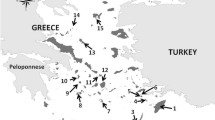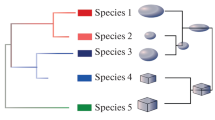Abstract
A procedure for dividing species into ecogeographic units (EGUs) and ecogeographic aggregations (EGAs) identified according to data on habitat gradients and distinctive features of migration (gene flows) is discussed. It is noted that every EGU or EGA can be regarded as a unit of reserves, reproduction, exploitation, or protection.







Similar content being viewed by others
REFERENCES
Abramov, N.V., Flora of the Republic of Mari El: inventory, analysis, zoning, safety, and the problem of sustainable use of its resources, Extended Abstract of Doctoral (Biol.) Dissertation in the Form of Report, Perm: Perm State Univ., 2001.
Allendorf, F.W., Luikart, G.H., and Aitken, S.N., Conservation and the Genetics of Populations, 2nd ed., West Sussex, UK: Wiley-Blackwell, 2012.
Altukhov, Yu.P., Geneticheskie protsessy v populyatsiyakh (Genetic Processes in Populations), Moscow: Nauka, 1983.
Bogdanov, G.A., Demakov, Yu.P., and Isaev, A.V., Skhema razvitiya seti osobo okhranyaemykh prirodnykh territorii Respubliki Marii El. Nauchnye fondy GPZ “Bol’shaya Kokshaga” (Scheme of Development of the Network of Specially Protected Natural Areas of the Republic of Mari El. Scientific Funds of the Bol’shaya Kokshaga State Nature Reserve), Yoshkar-Ola, 2015.
Chereshnev, I.A., Biogeografiya presnovodnykh ryb Dal’nego Vostoka (Biogeography of Freshwater Fishes of the Far East), Vladivostok: Dal’nauka, 1998.
Demakov, Yu.P., Struktura i zakonomernosti razvitiya lesov Respubliki Marii El (The Structure and Patterns of Forest Development in the Republic of Mari El), Yoshkar-Ola: Povolzh. Gos. Tekhn. Univ., 2018.
Denisova, L.V. and Vakhrameeva, M.G., Genus Cypripedium L. (lady’s slipper), in Biologicheskaya flora Moskovskoi oblasti (Biological Flora of Moscow Oblast), Moscow: Mosk. Gos. Univ., 1978, no. pp. 62–70.
Dionne, M., Caron, F., Dodson, J.J., and Bernatchez, L., Landscape genetics and hierarchical genetic structure in Atlantic salmon: the interaction of gene flow and local adaptation, Mol. Ecol., 2008, vol. 17, pp. 2382–2396.
Fraser, D.J., Weir, L.K., Bernatchez, L., Hansen, M.M., and Taylor, E.B., Extent and scale of local adaptation in salmonid fishes: review and meta-analysis, Heredity, 2011, vol. 106, pp. 404–420.
Funk, W.C., McKay, J.K., Hohenlohe, P.A., and Allendorf, F.W., Harnessing genomics for delineating conservation units, Trends Ecol. Evol., 2012, vol. 27, pp. 489–496.
Gagnaire, P.A., Normandeau, E., Côté, C., Hansen, M.M., and Bernatchez, L., The genetic consequences of spatially varying selection in the panmictic American eel (Anguilla rostrata), Genetics, 2012, vol. 190, pp. 725–736.
COSEWIC. Guidelines for Recognizing Designatable Units, 2015. http://www.cosewic.gc.ca/eng/sct2/sct2_5_e.cfm.
Quantum GIS, 2017. http://www.gisenglish.com/ 2017/12/download-free-qgis-21815-for-windows.html.
Map of River Basins of the Republic of Mari El. https://commons.wikimedia.org/wiki/File:Reki_Marii_El.svg. Accessed January 11, 2018.
Khanina, L.G., Zaugol’nova, L.B., Smirnov, V.E., and Glukhova, E.M., Method of analysis of vegetation biodiversity in reserves, in Otsenka i sokhranenie bioraznoobraziya lesnogo pokrova v zapovednikakh Evropeiskoi Rossii (Evaluation and Conservation of Biodiversity in Forest Cover in Reserves of the European Part of Russia), Moscow: Nauchnyi Mir, 2000, pp. 30–45.
Korytnyi, L.M., The basin concept: from hydrology to the nature management, Geogr. Prir. Res., 2017, no. 2, pp. 5–16.
Krasnaya kniga Respubliki Marii El (The Red Data Book of the Republic of Mari El), vol. Rasteniya. Griby (Plants. Fungi), Bogdanov, G.A., Abramov, N.V., Ubranavichyus, G.P., and Bogdanova, L.G., Eds., Yoshkar-Ola: Mar. Gos. Univ., 2013.
Lewontin, R.C., The Genetic Basis of Evolutionary Change, New York: Columbia Univ. Press, 1974.
Mayr, E., Animal Species and Evolution, Cambridge: Belknap Press, 1963.
Manel, S., Joost, S., Epperson, B.K., Holderegger, R., Storfer, A., Rosenberg, M.S., Scribner, K.T., Bonin, A., and Fortin, M.J., Perspectives on the use of landscape genetics to detect genetic adaptive variation in the field, Mol. Ecol., 2010, vol. 19, pp. 3760–3772.
Markov, M.V., Populyatsionnaya biologiya rastenii (Population Biology of Plants), Moscow: KMK, 2012.
Martynenko, A.B. and Bocharnikov, V.N., Ecological demarcation of the Far East, Izv. Akad. Nauk, Ser. Geogr., 2008, no. 2, pp. 76–84.
Mirkin, B.M. and Naumova, L.G., Nauka o rastitel’nosti (istoriya i sovremennoe sostoyanie osnovnykh kontseptsii) (Vegetation Science (History and Current State of the Basic Concepts)), Ufa: Gilem, 1998.
Moritz, C., Strategies to protect biological diversity and the evolutionary processes that sustain it, Syst. Biol., 2002, vol. 51, pp. 238–254.
National Atlas of Soils of the Russian Federation. Information Resources of the Faculty of Soil Science, Moscow State University. https://soilatlas.ru/. Accessed January 4, 2018.
Osmanova, G.O., Bogdanov, G.A., and Zhivotovsky, L.A., Specification of multispecies ecogeographic aggregations of rare plant species for the management of protected nature areas (on the example of Mari El Republic’s flora), Russ. J. Ecol., 2019, vol. 50, no. 5, pp. 460–464.
Pearse, D.E., Miller, M.R., Abadia-Cardoso, A., and Garza, J.C., Rapid parallel evolution of standing variation in a single, complex, genomic region is associated with life history in steelhead/rainbow trout, Proc. Roy. Soc. London: Biol. Sci., 2014, vol. 281, no. 1783. ID 20140012.
Perrier, C., Bourret, V., Kent, M.P., and Bernatchez, L., Parallel and nonparallel genome-wide divergence among replicate population pairs of freshwater and anadromous Atlantic salmon, Mol. Ecol., 2013, vol. 22, pp. 5577–5593.
Ramenskii, L.G., Tsatsenkin, I.A., Chizhikov, O.N., and Antipin, N.A., Ekologicheskaya otsenka kormovykh ugodii po rastitel’nomu pokrovu (Ecological Evaluation of Foraging Lands by the Vegetation Cover), Moscow: Sel’khozgiz, 1956.
Relief Map of the Republic of Mari El. https://commons.wikimedia.org/wiki/File:Relief_map_of_Mari_El.png. Accessed January 11, 2018.
Shvarts, S.S., Species population structure, Zool. Zh., 1967, vol. 46, pp. 1456–1469.
Smykov, A.E., Patterns of spatiotemporal dynamics of the basic parameters of the forest reserve of the Republic of Mari El, Extended Abstract of Cand. Sci. (Agricult.) Dissertation, Yoshkar-Ola: Mar. State. Tehn. Univ., 2008.
Sork, V.L. and Waits, L., Contributions of landscape genetics approaches, insights, and future potential, Mol. Ecol., 2010, vol. 19, pp. 3489–3495.
Stupishin, A.V., Lapteva, N.N., and Vasil’eva, D.P., Physical and geographical zoning of Mari ASSR, in Geograficheskii sbornik (Collection of Geographical Papers), Kazan: Kazan. Gos. Univ., 1969, no. 4, pp. 3–8.
Sukachev, V.N., Izbrannye raboty. Osnovy lesnoi tipologii i biogeotsenologii (Selected Works. Fundamentals of Forest Typology and Biogeocenology), Leningrad: Nauka, 1972, vol. 1.
Teramura, A.H., Experimental ecological genetics in Plantago. IX. Differences in growth and vegetative reproduction in Plantago lanceolata L. (Plantaginaceae) from adjacent habitat, Am. J. Bot., 1983, vol. 70, no. 1, pp. 53–58.
Timofeev-Resovskii, N.V., Yablokov, A.V., and Glotov, N.V., Ocherk ucheniya o populyatsii (Outline of the Doctrine of the Population), Moscow: Nauka, 1973.
Tsyganov, D.N., Fitoindikatsiya ekologicheskikh rezhimov v podzone khvoino-shirokolistvennykh lesov (Phytoindication of Ecological Regimes in the Subzone of Coniferous and Deciduous Forests), Moscow: Nauka, 1983.
Turkington, R. and Harper, J.L., The growth distribution and neighbor relationships of Trifolium repens a permanent pasture. IV. Fine-scale biotic differentiation, J. Ecol., 1979, vol. 67, pp. 245–254.
Vasil’eva, D.P., Landshaftnaya geografiya Mariiskoi ASSR (Physical Geography of Mari ASSR), Yoshkar-Ola: Mar. Knizh. Izd., 1979.
Waples, R.S., Pacific salmon, Oncorhynchus spp., and the definition of “species” under the Endangered Species Act, Mar. Fish. Rev., 1991, vol. 53, pp. 11–22.
Waples, R.S., Distinct population segments, in TheEndangered Species Act at Thirty, vol. 2: Conserving Biodiversity in Human-Dominated Landscapes, Washington, DC: Island Press, 2006, pp. 127–149.
Waples, R.S. and Gaggiotti, O., What is a population? An empirical evaluation of some genetic methods for identifying the number of gene pools and their degree of connectivity, Mol. Ecol., 2006, vol. 15, pp. 1419–1439.
Waples, R.S., Gustafson, R.G., Weitkamp, L.A., Myers, J., Johnson, O., Busby, P., Hard, J., Bryant, G., Waknitz, F., Neely, K., Teel, D., Grant, W., Winans, G., Phelps, S., Marshall, A., and Baker, B., Characterizing diversity in pacific salmon, J. Fish. Biol., 2001, vol. 59, suppl. A, pp. 1–41.
Woodland Map of the Republic of Mari El. https://fs00.infourok.ru/images/doc/160/185032/img50.jpg. Accessed January 11, 2018.
Yablokov, A.V., Populyatsionnaya biologiya (Population Biology), Moscow: Vysshaya Shkola, 1987.
Yang, J., Weedon, M.N., Purcell, S., Lettre, G., Estrada, K., Willer, C.J., Smith, A.V., Ingelsson, E., O’Connell, J.R., Mangino, M., Mägi, R., Madden, P.A., Heath, A.C., Nyholt, D.R., Martin, N.G., Montgomery, G.W., Frayling, T.M., Hirschhorn, J.N., McCarthy, M.I., Goddard, M.E., and Visscher, P.M., GIANT Consortium, Genomic inflation factors under polygenic inheritance, Eur. J. Hum. Genet., 2011, vol. 19, pp. 807–812.
Zaugol’nova, L.B., The hierarchical approach to the analysis of forest vegetation of a small river basin (on the example of the Prioksko-Terrasnyi Reserve), Bot. Zh., 1999, vol. 84, no. 8, pp. 42–56.
Zhivotovsky, L.A., Population structure of species: eco-geographic units and genetic differentiation between populations, Russ. J. Mar. Biol., 2016, vol. 42, no. 5, pp. 373–382.
Zhivotovsky, L.A., Two branches, ecological and genetic, in studying the species population structure: history, problems, and solutions, Russ. J. Genet., 2017, vol. 53, no. 11, pp. 1163–1171.
Zhivotovsky, L.A., Ecogeographic units and species reserve units in freshwater ecosystems (on the example of the chum salmon of Sakhalin Island), in Printsipy i sposoby sokhraneniya bioraznoobraziya: Mater. VII Mezhdunar. nauch. konf. (Principles and Methods for Biodiversity Conservation: Proc. VII Int. Sci. Conf.), Yoshkar-Ola: Vertikal’, 2019, pp. 276–278.
Zhivotovsky, L.A. and Osmanova, G.O., Ecogeographical approach to the identification of species population structure in plants, in Ekologiya i geografiya rastenii i rastitel’nykh soobshchestv: Mater. IV Mezhdunar. nauch. konf. (Ecology and Geography of Plants and Plant Communities: Proc. IV Int. Sci. Conf.), Yekaterinburg: ANO VO Gumanitarnyi universitet, 2018, pp. 282–285.
Zhivotovsky, L.A. and Osmanova, G.O., Populyatsionnaya biogeografiya rastenii (Plant Population Biogeography), Yoshkar-Ola: Vertikal’, 2019a.
Zhivotovsky, L.A. and Osmanova, G.O., Species population structure in plants: ecogeographic units, Biol. Bull. (Moscow), 2019b.
Zhivotovsky, L.A. and Osmanova, G.O., Ecogeographic units and population structure of a species, in Printsipy i sposoby sokhraneniya bioraznoobraziya: Mater. VII Mezhdunar. Nauchn. Konf. (Principles and Methods for Biodiversity Conservation: Proc. VII Int. Sci. Conf.), Yoshkar-Ola: Vertikal’, 2019c, pp. 10–13.
Zhivotovsky, L.A., Yurchenko, A.A., Nikitin, V.D., Safronov, S.N., Shitova, M.V., Zolotukhin, S.F., Makeev, S.S., Weiss, S., Rand, P.S., and Semenchenko, A.Yu., Eco-geographic units, population hierarchy, and a two-level conservation strategy with reference to a critically endangered salmonid, Sakhalin taimen Parahucho perryi,Conserv. Genet., 2015, vol. 16, pp. 431–441.
Zlobin, Yu.A., Populyatsionnaya ekologiya rastenii: sovremennoe sostoyanie, tochki rosta (Population Ecology of Plants: Current Status and Growth Points), Sumy: Universitetskaya Kniga, 2009.
Zlobin, Yu.A., Sklyar, V.G., and Klimenko, A.A., Populyatsii redkikh vidov rastenii (teoreticheskie osnovy i metodika izucheniya) (Populations of Rare Species of Plants (Theoretical Bases and Study Method)), Sumy: Universitetskaya Kniga, 2013.
Zverev, A.A.,Informatsionnye tekhnologii v issledovaniyakh rastitel’nogo pokrova (Information Technologies in Vegetation Cover Studies), Tomsk: TML Press, 2007.
Funding
This work was performed within the framework of the state-assigned theme GZ 0112-2019-2 (“Ecogenetic species structure” subtheme) and Basic Research Program no. 41 of the Presidium of the Russian Academy of Sciences “Natural System Biodiversity and the Biological Resources of Russia,” with financial support from the Russian Foundation for Basic Research (project no. 18-016-00033, work related to the identification of ecogeographic units).
Author information
Authors and Affiliations
Corresponding author
Ethics declarations
The authors declare that they have no conflict of interest. This article does not contain any studies involving animals or human participants performed by any of the authors.
Additional information
Translated by S. Semenova
Rights and permissions
About this article
Cite this article
Zhivotovsky, L.A., Osmanova, G.O. Ecogeographic Units and the Protection of Intraspecific Diversity. Biol Bull Russ Acad Sci 47, 123–134 (2020). https://doi.org/10.1134/S1062359020020144
Received:
Revised:
Accepted:
Published:
Issue Date:
DOI: https://doi.org/10.1134/S1062359020020144




